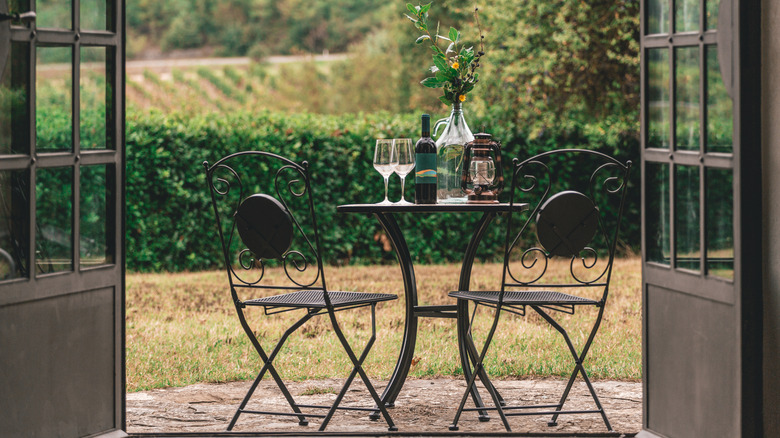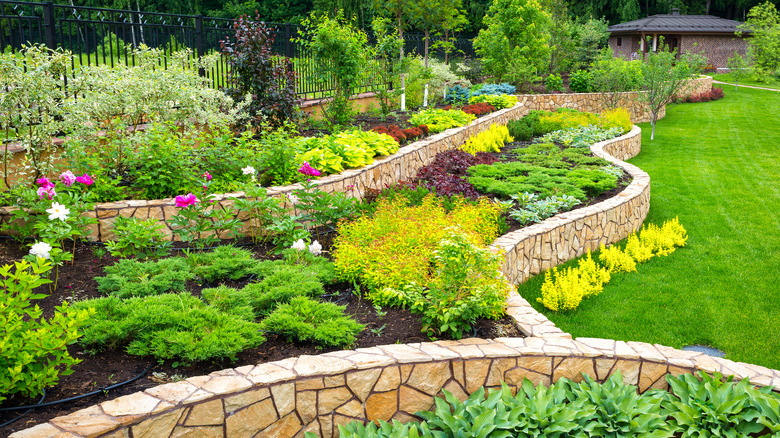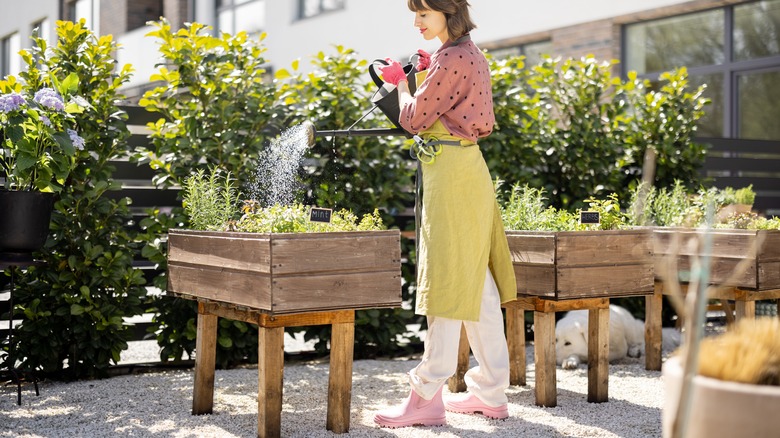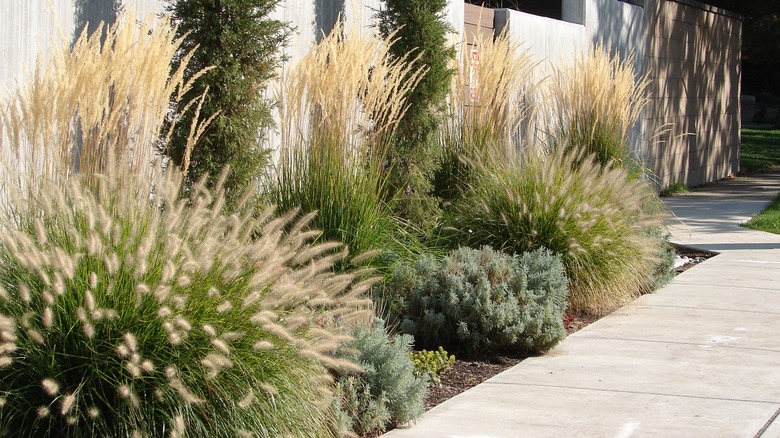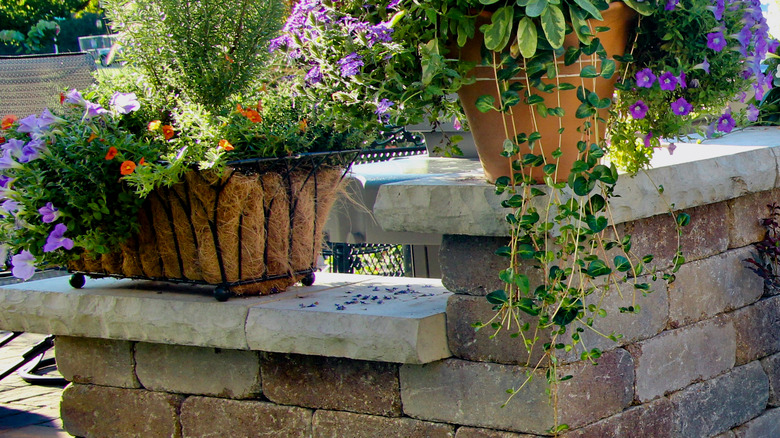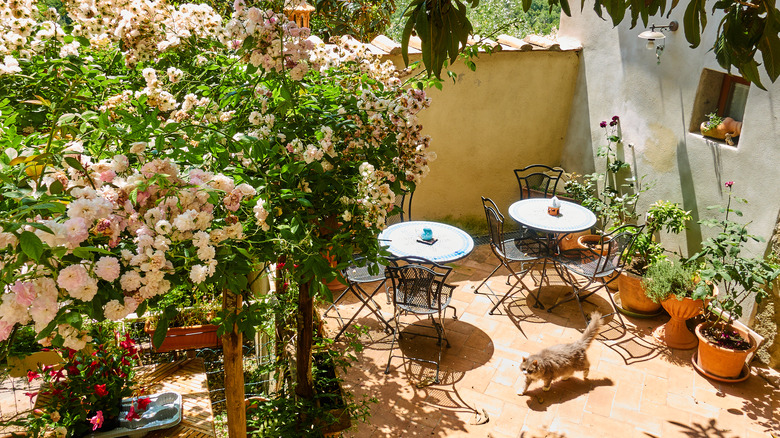What Is Tuscan Landscaping?
The Tuscany region of Italy has been inspiring food, home, and garden trends for centuries. Tuscan gardens evoke old-world sensibilities with their lush greenery, including many edible plants such as grapes and the herbs that are staples of classic Tuscan food, explains Architecture Art Designs. Tuscan landscaping often includes elaborate architecture that brings to mind rural villas, grand palaces, and even opulent Mediterranean castles like those you might see in Game of Thrones.
Tuscan gardens are popular for reasons beyond their impressive aesthetics. As mentioned, many Tuscan plants pull double duty not just as beautiful blooms, but also tasty and healthy ingredients. They're typically very low maintenance, which helps save time, money, and effort. Perhaps most striking of all, a good amount of Mediterranean plants are water efficient and don't require much hydration, notes Landscaping Network. With climate change and drought becoming an increasing issue for many communities, investing in a Tuscan garden may be a conscientious choice as well as a beautiful one.
Prioritize a warm color scheme
The first step to take when transforming your garden into a Tuscan landscape is to critically examine the color scheme of your prospective plants and landscaping features. While there are many aesthetically pleasing ways to incorporate cooler shades such as blue, gray, and green into your garden, for a true Tuscan vibe, you need to instead lean into the warmer colors of red, yellow, and orange, advises Landscaping Network. Cool shades are unavoidable to a degree when it comes to plants (most of which tend to be green, after all), so in order to increase warm hues, focus on patio materials and the inorganic elements of your garden.
Granite is a good option for adding warmth to your landscaping, as long as it's in a gold or yellow tone as opposed to the classic gray. For ground material, decomposed granite tends to be on the yellowish side, evoking the lighter, sandier soil of Italy. Earth Stone & Rock suggests Santa Barbara cobble — large sandstone rocks so named because of their prevalence in the stone architecture native to the California coast — as another great choice. Avoid basic gravel or concrete, which is more silvery and cool. Other schemes to avoid are pastels, which can be outshined by the bright colors of Tuscan flowers, and create a scene where all of the colors blur together. You want a color scheme that evokes visual contrast and keeps things interesting.
Bring in traditional Tuscan plants
Once you have your color scheme in order, it's time for the most fun part of any garden design process: picking which plants to bring home! Stay true to a core principle of Tuscan design by choosing plants that are both beautiful and functional. As Landscaping Network explains, gardens in Tuscany often feature a variety of aesthetically pleasing flora that are also fragrant, edible, or both. These plants include vegetables, herbs, and even fruit trees, in addition to your standard flowers and ornamentals.
Classic Tuscan herbs that can make your outdoor space look and, more importantly, smell like Italy, include rosemary, thyme, and lavender. Just remember that with lavender, less is definitely more, as it's one of the most fragrant and flavorful herbs. Tuscan gardens often feature aromatic trees such as cypress and bay trees. For fruit-bearing trees go with olives, figs, and citrus to provide you with fresh lemons, limes, oranges, or grapefruits. And don't forget one of the most unique features of the Tuscan landscape; snaking grape vines will lead to organically created natural walls and fences within your space. After all, what would Italian cuisine be without access to good grapes for making wine?
Build off of the conventional Tuscan motif
It can be difficult (and expensive) to adhere solely to traditional Tuscan plants, and of course, some of those plants won't thrive in every climate. If your garden temperatures are a far cry from the sunny Mediterranean skies and ocean breezes of coastal Italy, never fear. You can still evoke the feel of it by expanding your plant repertoire to Tuscan-adjacent specimens. Landscaping Network recommends planting ornamental grasses, which tend to be hardier and more cold-resistant than traditional Tuscan plant choices. American Meadows provides a helpful breakdown of which grasses grow best in certain environments, including deer grass, Lindheimer's muhly, and moor grass. Grasses are not a conventional aspect of Tuscan-style landscaping, but they can add flow to your garden and help offset some of the more visually striking aspects of your design, such as stone features.
Other plants that are not traditionally incorporated into Tuscan gardens but fit well in the overall design scheme include pearl blue bush, Mediterranean fan palm (really any Mediterranean plants will do), and varieties of sage such as Cleveland, Jerusalem, white, or bee's bliss, many of which are also edible. Succulents evoke the sunny, beachy vibe of Tuscany, just don't go overboard. Since succulents are so aesthetically pleasing and simple to maintain, it's easy to become really excited about them and end up with a succulent garden on your patio instead of a Tuscan landscape.
Incorporate hardscaping elements
Tuscan landscapes are often thought of as lower maintenance than other types of gardens. While that can be true when it comes to taking care of the plants, most of which require little attention once they're established, the actual process of designing a Tuscan garden can involve a lot of initial effort because, historically, the style incorporates more formal landscaping and architectural choices. A large component of that formality comes in the form of hardscape elements. Hardscaping is defined by Merriam-Webster as "structures (such as fountains, benches, or gazebos) that are incorporated into a landscape." For Tuscan gardens, structures include promenades, or stone walkways, that wind throughout the garden to let you access all of the plants. In addition to contributing to your garden's aesthetics, these walkways are helpful for plant maintenance, notes MasterClass.
Another good hardscaping option for a Tuscan landscape is a patio area directly incorporated into the yard. The patio should not be visible from all angles, so that your garden visitors turn a corner to unexpectedly find a fire pit and chairs, or a wooden pergola. You can also use smaller hardscaping structures to contrast with the lush growth produced by the abundant plants. These pieces can take the form of stone urns, low walls, or tall, thin statues, all in the traditional warm Tuscan shades of red and gold, as mentioned above.
Create rooms within your landscape
Walking through a true Tuscan-themed landscape should feel like an adventure, where you never know what lies around the corner. Tuscan landscapes use design elements to build outdoor "rooms" within a garden space so that specific areas feel sectioned off from other components of the garden, almost like their own environments, per Landscaping Network. You may think you need a yard that's on the bigger side to have more than one room in your garden, but this distinctive Tuscan element can absolutely be achieved within a smaller space.
One simple way to create a divided feel in your yard is to use hedges to build walls in your garden area — just be conscientious about maintaining them, since overgrown shrubs can look sloppy and, therefore, the antithesis of Tuscan. A lower-maintenance alternative is to plant bands of trees as natural walls instead.
Not sure what should be considered a separate outdoor room? As mentioned above, your patio or social space can be a room unto itself. You can also take inspiration from Vogue's profile of a professional Tuscan garden designer, Luciano Giubbilei, whose garden's rooms include a vegetable patch, a courtyard, and a flower display. Additional ideas to consider are a dining area, relaxation space, water feature, or patio herb garden. The possibilities are wide when invoking beautiful Tuscany!
